The Light Saber: An Odyssey
Jun 2, 2011 2:56:54 GMT
Post by Kilted Cossack on Jun 2, 2011 2:56:54 GMT
Gents:
A few years ago when I realized there was a flourishing market in decent reproduction swords, I decided I just had to get me one. (One?) I looked around the web for a while and found SBG, and the old SBG forum, and commenced to educating myself. One of the first swords I bought was a Windlass American Revolutionary War Saber from KOA. (If you don't know what the Windlass American Revolutionary War Saber looks like, hie yourself over to KOA and refresh your recollections!)
Oh, and from here on out, I'll be calling the Windlass American Revolutionary War Saber just "the Saber."
When I got the Saber, I was pleased as punch with it, which, I suppose, only goes to show you how pig-ignorant I was at the time. I flipped through my Neumann until I found a reasonable facsimile of the Saber, ran my thumb along the secondarily-beveled edge and whacked up a couple of two liter bottles. What more could a fellow want?
Well, a fellow could want an education, for one thing.
As I began to slowly, ever so slowly, educate myself about swords in general (and, here, sabers in particular), I began to realize that there were things about the Saber that, well, weren't quite right. (By which I mean, they were wrong.) One of the first things I began to understand was distal taper. The problem with the Saber is that it doesn't have any, or not much, anyhow. I've read enough about European military sabers to realize that they started off thick, brother, and then got thin quick. I've seen numbers up to about 10mm---for us non-metric types, that's .40"! (For us non-decimal types, that's 2/5"!) Then the blade thins out, generally fairly quickly. Well, the Saber probably started life as a piece of 3/16" stock, and that's 3/16 from the threaded end of the tang almost out to the end of the blade.
The other two problems were both related to the grip: one was grip length, and the other was grip angle. KOA lists the grip length of the Saber as 3 7/8". For me, that's workable, but only "just barely" and bare handed at that. No fancy gloves like Dave Kelly has for me, not if I'm swinging a stock Saber! The grip was short enough that it more or less locked my hand into place. I was not content.
As for the grip angle, I will probably have trouble explaining, but the tang continued the curve of the blade, like a segment of an arc. It was, I guess, like a katana's grip, whereas just about every saber I've ever seen incorporates a recurved grip, that curves away from the angle of the curve on the blade. (A fine, to my mind, example of the power of leverage, and the reason I insist that Archimedes must have been a swordsman.) A recurved grip won't change the POB, but it will change the feel in the hand, and besides, it could bring the point more in line with the wrist for enhanced pokiness.
So, there I was. I had gone from being pig-ignorant and entirely happy with my sword, to being only mostly ignornant, and convinced that the Saber was a really poor replica of an American saber from the Revolutionary War period. What to do, what to do, whatever to do?
For a while I thought about using it as a beater until it was used up, or just chalking the whole experience up to my previous pig-ignorance, but the more I thought about it, the more I was convinced that something good could be salvaged from this Saber. For one thing, I really like the blade. Thin, yes, but well tempered, and a good cutter even with the secondary edge bevel.
I have done a tiny bit of parts-swapping among swords, and been pretty happy with the outcome, fitting a EMSHS blade with a Cold Steel basket hilt and fitting the guard from a Hanwei Renaissance Side Sword to a VA AT303S. Each of those had involved a bit of metal work, but this would involve not merely grinding, but heating and reshaping the tang. (I gots to have me some recurve to my grip.)
Before I could come to any real conclusions, however, I needed to know what I was working with. I fired up the bench grinder and got to work. Grinding off the peen only took a moment, and I unscrewed the "peen block." Quick note: I don't know how heavy the peen is on other peened swords, but there wasn't all that much to this one. I have every confidence in the setup, though, as the threaded "peen block" engages a good portion of the threaded tang, with the peen block doing most of the work and the peen itself playing the role of Loc-Tite. Due to the curve of the grip, I couldn't remove the D-guard without cutting it loose. Ah well, it was too small anyway, right?
I didn't document the process, but it went through two tang heat-and-bend sessions, two different guards and about six different grips. I recurved the tang (twice) and ended up, scraped up and scratched and with a ghastly orange patch of high tech adhesive on my knee, vastly satisfied with myself.
Here's what I did: I made myself a cossack saber.

I mean, I've always liked the cossacks. (The name, I think, kind of gives it away.) The whole "frontiers of Ukraine" thing, the wild freedom thing, the scalp locks, the sabers, the horsemanship. Baggy trousers and wide sashes. And the scalp locks! (Did I mention the scalp locks?) I've been fascinated by Central Asia since I read Eastern Approaches when I was just a sprout, and living and working in Kazakhstan for a couple of years didn't do anything to dim that fascination. Plus, of course, "Cossack" itself is derived from the same root as "Kazakh" and "Kazakhstan." Free, wild, roaming, unfettered, masterless, nomadic, kind of something along those lines. The ronin of the steppe.
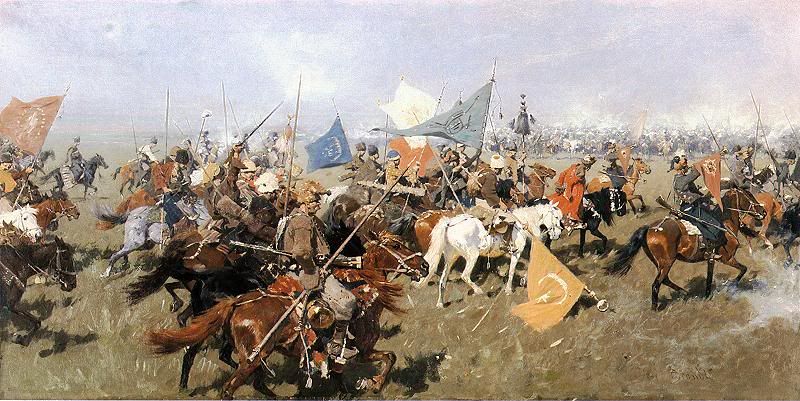
Over the centuries the cossacks fell increasingly under the influence of the tsars in Moscow (and then St. Petersburg), and pushed forward the frontiers of the Russian Empire. Eventually, somewhere along the way, the cossacks began to be identified by the shashka---the guardless saber from the Caucasus. That's the direction I ended up going in, but before that I tried my hand at putting together an Armenian style fiddlestick saber, another light and fast saber. I fitted the cross guard from the Valiant AT303S, and re-used the pommel from the Saber's original incarnation . . . but I just wasn't happy with it, so I scrapped that idea, and went back to the shashka.
Shashka, shasqua, whatever---I speak Russian, and the direct transliteration from Russian to English is "shashka," so that's what I'm sticking with. Somewhere, I'll have to try and track it back down, I saw a video from Russian television, an interview with a Caucasian shashka master. He explained that the shashka wasn't like most sabers, it wasn't thick like most sabers. See, the shashka originated as a knife, not a sword. The shashka was the traditional pruning knife used to trim back grape vines, and had been adapted into a weapon. (I'd love to know when that took place, and if it was under influence of hard riding steppe nomads.)
Wait, did someone say the shashka had a thin blade, unlike most sabers? And did I, a boy cutler who goes by Kilted Cossack, hear that, while I was trying to decide what to do with a well tempered blade that was, umm, thin? Why yes, someone did say that, and yes, I did hear it.
It was like in Monty Python and the Holy Grail when the heavens roll back and everything is made clear.
I was going to make a shashka, not a fiddlestick Armenian saber at all! And I did. My first effort didn't quite work out. I made a fresh grip out of poplar, but my inletting was off and when I got it all glued together the grip was canted. Oh, and the grip was far too "yataghany" for my taste, the more I looked at it. I decided I needed to redo the grip yet again, but kept working at shaping this one while I developed a hand feel for what I wanted out of a grip. When I got it close to where I wanted it, I tore the grip off and redid it.
Glue? Oh yeah, baby. In one of my very early posts at the old SBG forum, I said that as long as a sword duplicated the feel of a traditional sword, I could care less how it was put together. Pound voce ground? Don't matter to me! Hot peened vice hex nut? I could care a less. If it's a good sword, securely put together, I don't care if it was water-jet cut from a cold-rolled billet and held together with superglue with a guard cast in a mold.
Besides, I wasn't sure how else to go about it.
Here's what I did. I cut 1/4" poplar slats to match the outline of the tang and then glued 1/4" poplar scales onto those slats, and then cut away everything that didn't look and feel like a grip. Even with the fairly severely curved tang, this left me with a grip core that slid on and off easily. I used some form of super wood glue---I don't have the bottle in front of me now. Then I kneaded together some JB Weld and pushed it up into the bottom of the grip, let it set up just a little, then guesstimated how much Gorilla Glue I needed to use in the grip channel, and slid it all together. There was the tiniest little bit of wiggle room as everything set up, and I managed to get it balanced just right, so that the blade isn't canted (at all! so far as I can tell!)
Here's where I've ended up, so far. This Saber is now a very, very light saber. It clocks in at----are you sitting down?----one pound four ounces. By way of comparison, earlier I mentioned the VA arming sword fitted with the compound guard? It weighs two pounds eight ounces. It's twice as heavy! The point of balance is way out there, between eleven and twelve inches from where the guard would be, if there was a guard. The grip is 4 1/2" long to the inner edge of the ears, and 6" overall. The grip brings the point of the blade into line with the wrist when gripped with the thumb along the backstrap.
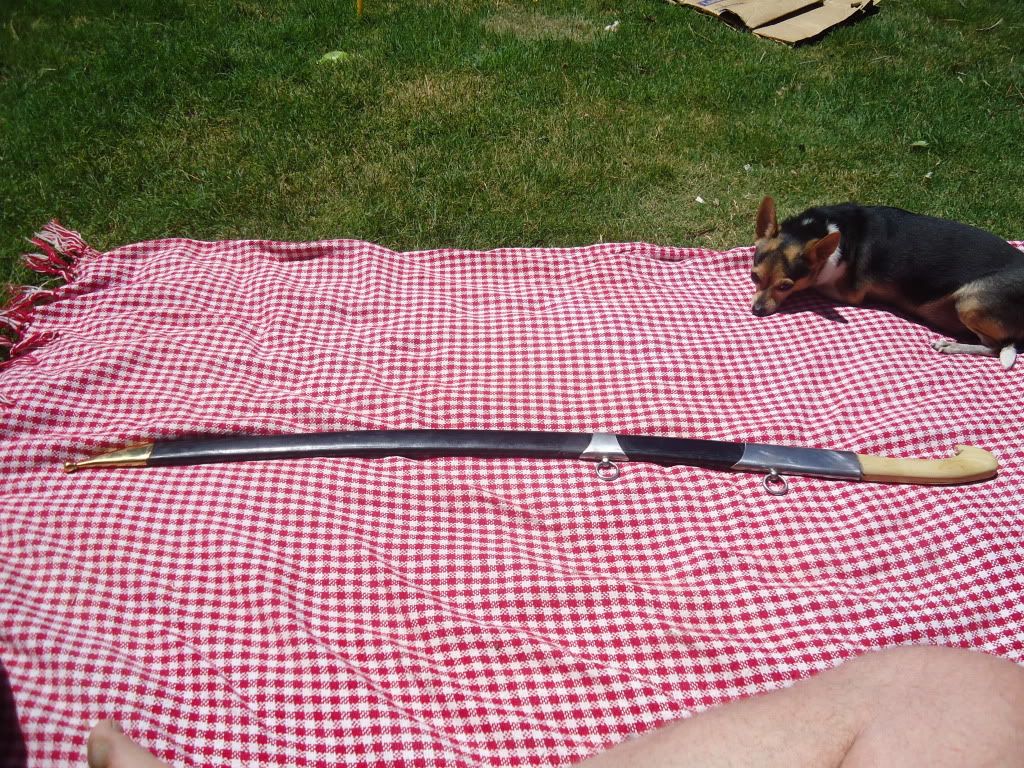
While the ridiculously distant POB seems to belie this, the Saber (or, I suppose, now more properly "the Shashka") is quite fencible. It does weigh, after all, just north of a pound, and the reshaped grip gives good leverage over that light weight. It is easy to work the point, and it penetrates well on two liter and 20 ounce bottles. (Then again, it seems everything I've poked with penetrates well on those bottles.) I've done only a little cutting work with it: two two liter bottles with "good downright blows" (so to speak) and three twenty ounce bottles with "snap cuts" (which seem, to my mind, to be the Shashka's forte).
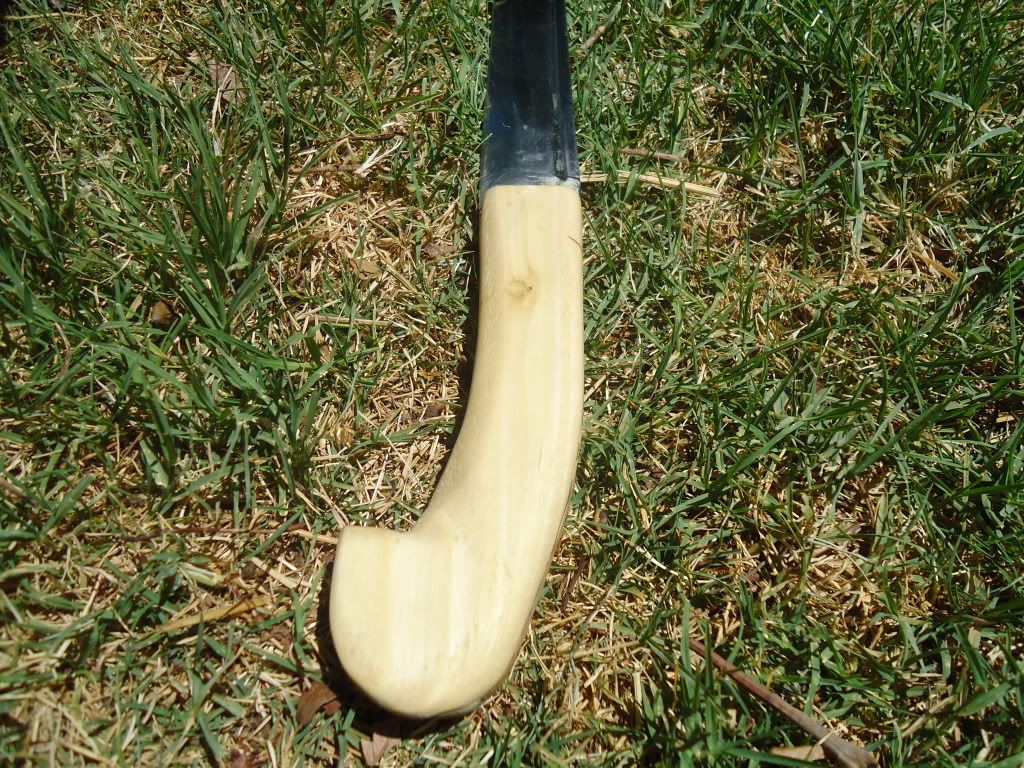
I haven't cut in over a year, and I'm still getting used to cutting in general and this whole new saber in particular. The first cut on a two liter I batted it. After retrieval, the second cut gashed most of the way through the bottle. On the final two liter, I got a clean cut, but the bottle fell. With the twenty ouncers? Three clean cuts, and two of the bottles were left standing.
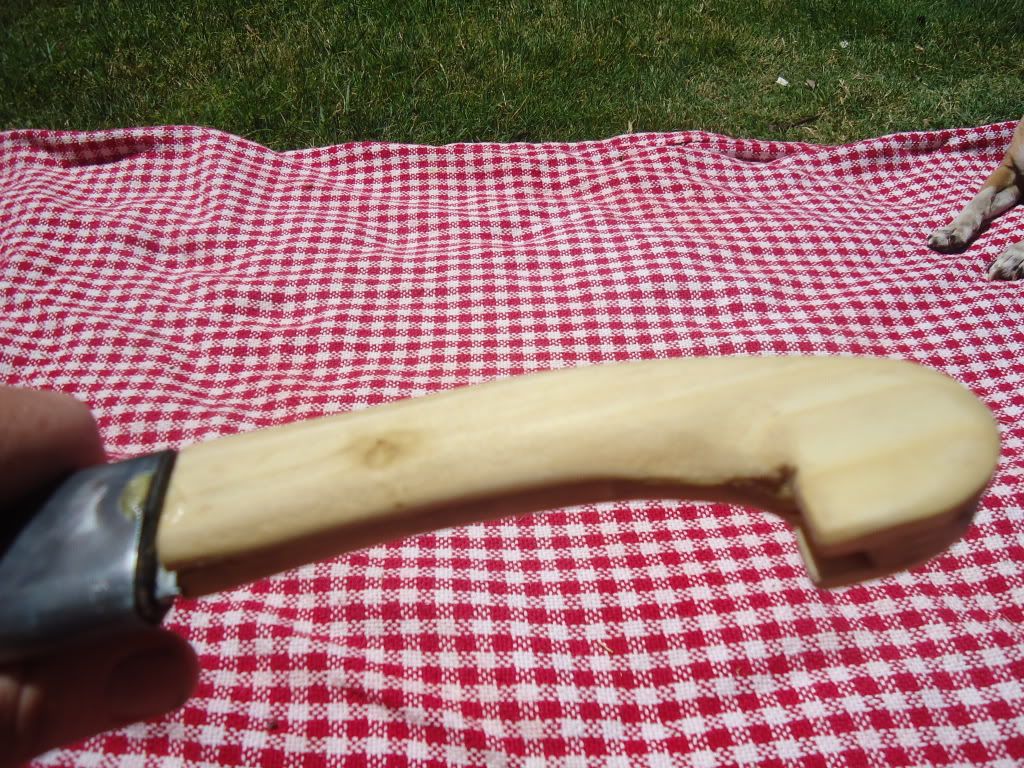
The pictures don't really show it, but I incorporated what I pompously call the Cossack Wedge Principle on the grip. The backstrap, that is, is wider than the frontstrap. (I'm sure no one has ever thought of this before, ahem, ahem.) This seems to help with edge alignment, and I can use all the help I can get. When performing snap cuts, the ears do a good job of arresting hand movement, and the palm slides comfortably down the curve of the backstrap.
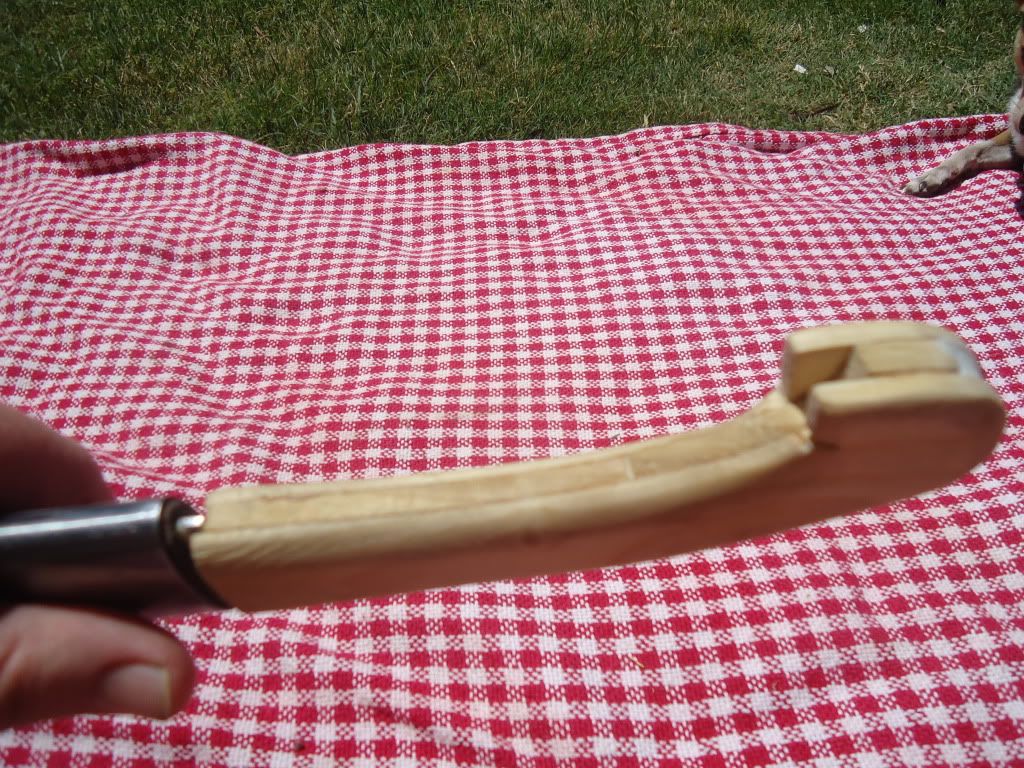
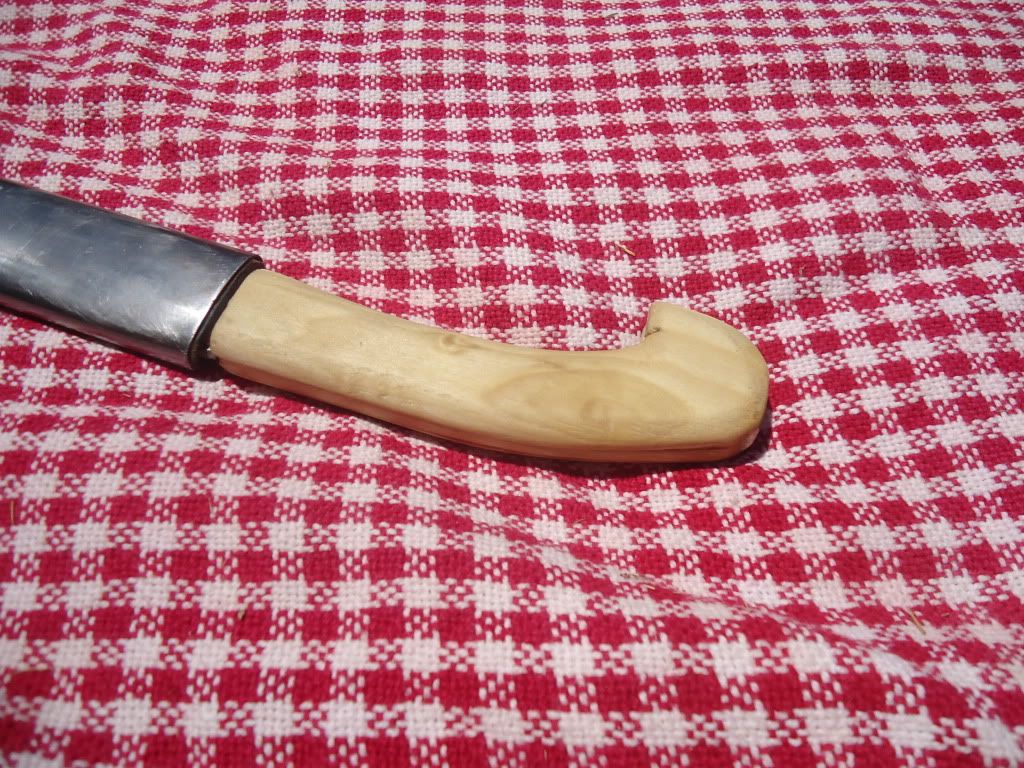
Look, I know Jake Powning and Christian Fletcher aren't thinking they'll have to step up their game. Basically I reshaped the tang and made a new grip. Big deal, really. But dang it's been fun, and I am happy with the results. I looked at a Saber that had some really good qualities, mixed in with some design flaws. I have learned enough about swords by this point that I could actually puzzle out the good and the bad, and try to do something about it. I adjusted my concept along the way, a number of times, but at no time did I feel horribly put upon or depressed. If I hit a snag, I figured out a way around it, and if sometimes I had to back up and start over, well, gee, life's like that sometimes. I worked at it, and I accomplished something. I managed to salvage a blade I liked, and set it up in a way that played to its strengths, and in a way, moreover, that has personal significance to me.


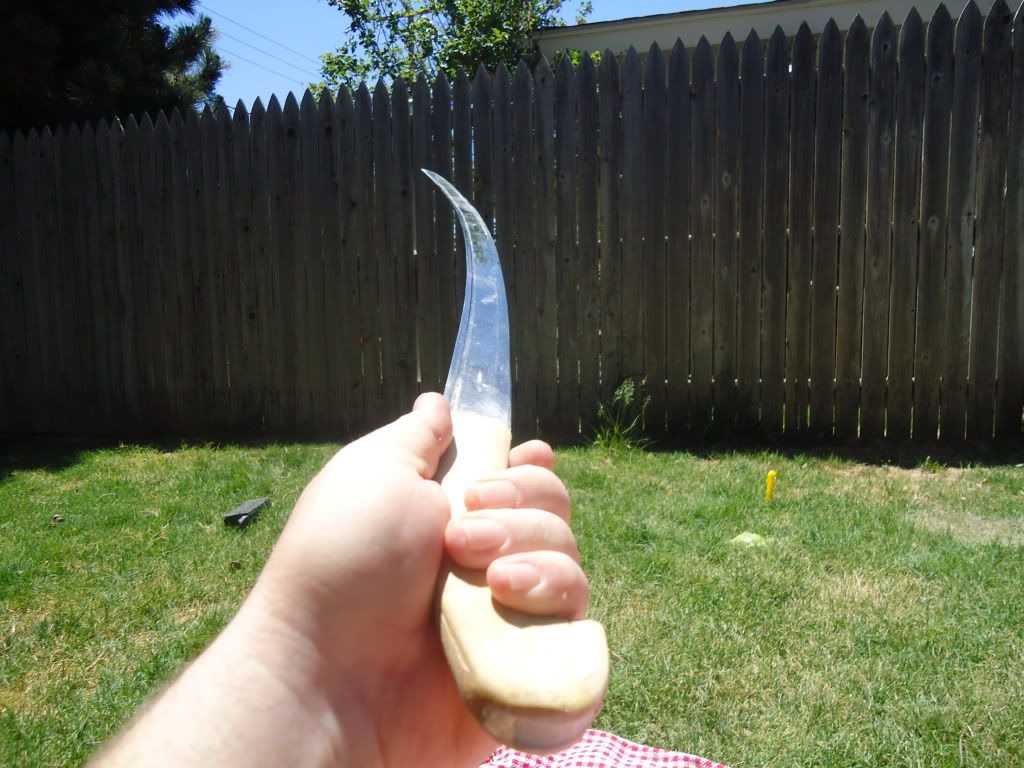
Yay me!
A few years ago when I realized there was a flourishing market in decent reproduction swords, I decided I just had to get me one. (One?) I looked around the web for a while and found SBG, and the old SBG forum, and commenced to educating myself. One of the first swords I bought was a Windlass American Revolutionary War Saber from KOA. (If you don't know what the Windlass American Revolutionary War Saber looks like, hie yourself over to KOA and refresh your recollections!)
Oh, and from here on out, I'll be calling the Windlass American Revolutionary War Saber just "the Saber."
When I got the Saber, I was pleased as punch with it, which, I suppose, only goes to show you how pig-ignorant I was at the time. I flipped through my Neumann until I found a reasonable facsimile of the Saber, ran my thumb along the secondarily-beveled edge and whacked up a couple of two liter bottles. What more could a fellow want?
Well, a fellow could want an education, for one thing.
As I began to slowly, ever so slowly, educate myself about swords in general (and, here, sabers in particular), I began to realize that there were things about the Saber that, well, weren't quite right. (By which I mean, they were wrong.) One of the first things I began to understand was distal taper. The problem with the Saber is that it doesn't have any, or not much, anyhow. I've read enough about European military sabers to realize that they started off thick, brother, and then got thin quick. I've seen numbers up to about 10mm---for us non-metric types, that's .40"! (For us non-decimal types, that's 2/5"!) Then the blade thins out, generally fairly quickly. Well, the Saber probably started life as a piece of 3/16" stock, and that's 3/16 from the threaded end of the tang almost out to the end of the blade.
The other two problems were both related to the grip: one was grip length, and the other was grip angle. KOA lists the grip length of the Saber as 3 7/8". For me, that's workable, but only "just barely" and bare handed at that. No fancy gloves like Dave Kelly has for me, not if I'm swinging a stock Saber! The grip was short enough that it more or less locked my hand into place. I was not content.
As for the grip angle, I will probably have trouble explaining, but the tang continued the curve of the blade, like a segment of an arc. It was, I guess, like a katana's grip, whereas just about every saber I've ever seen incorporates a recurved grip, that curves away from the angle of the curve on the blade. (A fine, to my mind, example of the power of leverage, and the reason I insist that Archimedes must have been a swordsman.) A recurved grip won't change the POB, but it will change the feel in the hand, and besides, it could bring the point more in line with the wrist for enhanced pokiness.
So, there I was. I had gone from being pig-ignorant and entirely happy with my sword, to being only mostly ignornant, and convinced that the Saber was a really poor replica of an American saber from the Revolutionary War period. What to do, what to do, whatever to do?
For a while I thought about using it as a beater until it was used up, or just chalking the whole experience up to my previous pig-ignorance, but the more I thought about it, the more I was convinced that something good could be salvaged from this Saber. For one thing, I really like the blade. Thin, yes, but well tempered, and a good cutter even with the secondary edge bevel.
I have done a tiny bit of parts-swapping among swords, and been pretty happy with the outcome, fitting a EMSHS blade with a Cold Steel basket hilt and fitting the guard from a Hanwei Renaissance Side Sword to a VA AT303S. Each of those had involved a bit of metal work, but this would involve not merely grinding, but heating and reshaping the tang. (I gots to have me some recurve to my grip.)
Before I could come to any real conclusions, however, I needed to know what I was working with. I fired up the bench grinder and got to work. Grinding off the peen only took a moment, and I unscrewed the "peen block." Quick note: I don't know how heavy the peen is on other peened swords, but there wasn't all that much to this one. I have every confidence in the setup, though, as the threaded "peen block" engages a good portion of the threaded tang, with the peen block doing most of the work and the peen itself playing the role of Loc-Tite. Due to the curve of the grip, I couldn't remove the D-guard without cutting it loose. Ah well, it was too small anyway, right?
I didn't document the process, but it went through two tang heat-and-bend sessions, two different guards and about six different grips. I recurved the tang (twice) and ended up, scraped up and scratched and with a ghastly orange patch of high tech adhesive on my knee, vastly satisfied with myself.
Here's what I did: I made myself a cossack saber.

I mean, I've always liked the cossacks. (The name, I think, kind of gives it away.) The whole "frontiers of Ukraine" thing, the wild freedom thing, the scalp locks, the sabers, the horsemanship. Baggy trousers and wide sashes. And the scalp locks! (Did I mention the scalp locks?) I've been fascinated by Central Asia since I read Eastern Approaches when I was just a sprout, and living and working in Kazakhstan for a couple of years didn't do anything to dim that fascination. Plus, of course, "Cossack" itself is derived from the same root as "Kazakh" and "Kazakhstan." Free, wild, roaming, unfettered, masterless, nomadic, kind of something along those lines. The ronin of the steppe.

Over the centuries the cossacks fell increasingly under the influence of the tsars in Moscow (and then St. Petersburg), and pushed forward the frontiers of the Russian Empire. Eventually, somewhere along the way, the cossacks began to be identified by the shashka---the guardless saber from the Caucasus. That's the direction I ended up going in, but before that I tried my hand at putting together an Armenian style fiddlestick saber, another light and fast saber. I fitted the cross guard from the Valiant AT303S, and re-used the pommel from the Saber's original incarnation . . . but I just wasn't happy with it, so I scrapped that idea, and went back to the shashka.
Shashka, shasqua, whatever---I speak Russian, and the direct transliteration from Russian to English is "shashka," so that's what I'm sticking with. Somewhere, I'll have to try and track it back down, I saw a video from Russian television, an interview with a Caucasian shashka master. He explained that the shashka wasn't like most sabers, it wasn't thick like most sabers. See, the shashka originated as a knife, not a sword. The shashka was the traditional pruning knife used to trim back grape vines, and had been adapted into a weapon. (I'd love to know when that took place, and if it was under influence of hard riding steppe nomads.)
Wait, did someone say the shashka had a thin blade, unlike most sabers? And did I, a boy cutler who goes by Kilted Cossack, hear that, while I was trying to decide what to do with a well tempered blade that was, umm, thin? Why yes, someone did say that, and yes, I did hear it.
It was like in Monty Python and the Holy Grail when the heavens roll back and everything is made clear.
I was going to make a shashka, not a fiddlestick Armenian saber at all! And I did. My first effort didn't quite work out. I made a fresh grip out of poplar, but my inletting was off and when I got it all glued together the grip was canted. Oh, and the grip was far too "yataghany" for my taste, the more I looked at it. I decided I needed to redo the grip yet again, but kept working at shaping this one while I developed a hand feel for what I wanted out of a grip. When I got it close to where I wanted it, I tore the grip off and redid it.
Glue? Oh yeah, baby. In one of my very early posts at the old SBG forum, I said that as long as a sword duplicated the feel of a traditional sword, I could care less how it was put together. Pound voce ground? Don't matter to me! Hot peened vice hex nut? I could care a less. If it's a good sword, securely put together, I don't care if it was water-jet cut from a cold-rolled billet and held together with superglue with a guard cast in a mold.
Besides, I wasn't sure how else to go about it.
Here's what I did. I cut 1/4" poplar slats to match the outline of the tang and then glued 1/4" poplar scales onto those slats, and then cut away everything that didn't look and feel like a grip. Even with the fairly severely curved tang, this left me with a grip core that slid on and off easily. I used some form of super wood glue---I don't have the bottle in front of me now. Then I kneaded together some JB Weld and pushed it up into the bottom of the grip, let it set up just a little, then guesstimated how much Gorilla Glue I needed to use in the grip channel, and slid it all together. There was the tiniest little bit of wiggle room as everything set up, and I managed to get it balanced just right, so that the blade isn't canted (at all! so far as I can tell!)
Here's where I've ended up, so far. This Saber is now a very, very light saber. It clocks in at----are you sitting down?----one pound four ounces. By way of comparison, earlier I mentioned the VA arming sword fitted with the compound guard? It weighs two pounds eight ounces. It's twice as heavy! The point of balance is way out there, between eleven and twelve inches from where the guard would be, if there was a guard. The grip is 4 1/2" long to the inner edge of the ears, and 6" overall. The grip brings the point of the blade into line with the wrist when gripped with the thumb along the backstrap.

While the ridiculously distant POB seems to belie this, the Saber (or, I suppose, now more properly "the Shashka") is quite fencible. It does weigh, after all, just north of a pound, and the reshaped grip gives good leverage over that light weight. It is easy to work the point, and it penetrates well on two liter and 20 ounce bottles. (Then again, it seems everything I've poked with penetrates well on those bottles.) I've done only a little cutting work with it: two two liter bottles with "good downright blows" (so to speak) and three twenty ounce bottles with "snap cuts" (which seem, to my mind, to be the Shashka's forte).

I haven't cut in over a year, and I'm still getting used to cutting in general and this whole new saber in particular. The first cut on a two liter I batted it. After retrieval, the second cut gashed most of the way through the bottle. On the final two liter, I got a clean cut, but the bottle fell. With the twenty ouncers? Three clean cuts, and two of the bottles were left standing.

The pictures don't really show it, but I incorporated what I pompously call the Cossack Wedge Principle on the grip. The backstrap, that is, is wider than the frontstrap. (I'm sure no one has ever thought of this before, ahem, ahem.) This seems to help with edge alignment, and I can use all the help I can get. When performing snap cuts, the ears do a good job of arresting hand movement, and the palm slides comfortably down the curve of the backstrap.


Look, I know Jake Powning and Christian Fletcher aren't thinking they'll have to step up their game. Basically I reshaped the tang and made a new grip. Big deal, really. But dang it's been fun, and I am happy with the results. I looked at a Saber that had some really good qualities, mixed in with some design flaws. I have learned enough about swords by this point that I could actually puzzle out the good and the bad, and try to do something about it. I adjusted my concept along the way, a number of times, but at no time did I feel horribly put upon or depressed. If I hit a snag, I figured out a way around it, and if sometimes I had to back up and start over, well, gee, life's like that sometimes. I worked at it, and I accomplished something. I managed to salvage a blade I liked, and set it up in a way that played to its strengths, and in a way, moreover, that has personal significance to me.



Yay me!




 Pretty cool, man... I might have to do this myself one of these days...
Pretty cool, man... I might have to do this myself one of these days...

